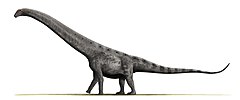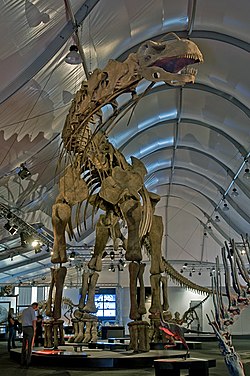Argentynozaur
| Argentinosaurus | |||
| Bonaparte & Coria, 1993 | |||
| Okres istnienia: 97–93,5 mln lat temu | |||
 Argentinosaurus huinculensis | |||
| Systematyka | |||
| Domena | |||
|---|---|---|---|
| Królestwo | |||
| Typ | |||
| Podtyp | |||
| Gromada | |||
| Podgromada | |||
| Nadrząd | |||
| Rząd | |||
| Podrząd | |||
| Infrarząd | |||
| (bez rangi) | tytanozaury | ||
| Rodzina | |||
| Rodzaj | argentynozaur | ||
| Gatunki | |||
| |||
Argentynozaur (Argentinosaurus) – dinozaur gadziomiedniczny z grupy zauropodów, odkryty przez Guillermo Heredia w Argentynie. Żył on na terenie Ameryki Południowej, w okresie kredowym pomiędzy 97 a 93,5 miliona lat temu[2]. Rodzaj obejmuje jeden gatunek – Argentinosaurus huinculensis.
Opis
Szkielet Argentynozaura jest niekompletny. Holotyp zawiera serię kręgów (sześć grzbietowych, 5 z regionu bioder), żebra i prawy piszczel długości 1,55 metra[3]. Dodatkowo przypisuje mu się niekompletną kość udową, która mogła mierzyć ponad 2,5 metra, dla porównania kość udowa innego tytanozaura patagotitana mierzyła 2,38 metra[4][5].
Wielkość
Ze względu na niekompletność szczątków kopalnych wielkość argentynozaura jest przedmiotem sporu. Szacunkowo mierzył on ponad 30 metrów i ważył około 70 ton. Czyniło by go to największym znanym dinozaurem[6].
Odkrycie
Szczątki argentynozaura zostały odnalezione przez miejscowego farmera, który pomylił je ze skamieniałym drewnem.
Gatunek typowy A. huinculensis został opisany przez paleontologów José F. Bonaparte i Rodolfo Coria[3].
Systematyka
Argentynozaur zalicza się do tytanozaurów, zaawansowanej grupy zauropodów. Bonaparte i Coria początkowo zaklasyfikowali go jako andezaura[3].
Odkrycie spokrewnionego patagotitana dostarczyło nowych informacji w sprawie klasyfikacji argentynozaura. W 2017 Carbadillo i współpracownicy stwierdzili iż argentynozaur jest przedstawicielem bardziej zaawansowanego kladu Lognkosauria[7]. Badania González'a Riga i współpracowników również potwierdziły przynależność argentynozaura do Lognkosauria[8].
Przypisy
- ↑ José F. Bonaparte, Rodolfo A. Coria. Un nuevo y gigantesco sauropodo titanosaurio de la Formacion Rio Limay (Albiano-Cenomaniano) de la Provincia del Neuquen, Argentina. „Ameghiniana”. 30 (3), s. 271-282, 1993 (hiszp.).
- ↑ Holtz, Thomas R. Jr. (2012) Dinosaurs: The Most Complete, Up-to-Date Encyclopedia for Dinosaur Lovers of All Ages,Winter 2011 Appendix.
- ↑ a b c Bonaparte J, Coria R (1993). "Un nuevo y gigantesco sauropodo titanosaurio de la Formacion Rio Limay (Albiano-Cenomaniano) de la Provincia del Neuquen, Argentina". Ameghiniana (in Spanish). 30 (3): 271–282.
- ↑ Gerardo V. Mazzetta, Per Christiansen, Richard A. Fariña, Giants and Bizarres: Body Size of Some Southern South American Cretaceous Dinosaurs, „Historical Biology”, 16 (2–4), 2004, s. 71–83, DOI: 10.1080/08912960410001715132 [dostęp 2008-01-08].
- ↑ José L. Carballido i inni, A new giant titanosaur sheds light on body mass evolution among sauropod dinosaurs, „Proceedings of the Royal Society B: Biological Sciences”, 284 (1860), royalsocietypublishing.org, 2017, DOI: 10.1098/rspb.2017.1219, PMID: 28794222, PMCID: PMC5563814 [dostęp 2019-02-14].
- ↑ Gregory Paul, Determining the Largest Known Land Animal: A Critical Comparison of Differing Methods for Restoring the Volume and Mass of Extinct Animals, „Annals of Carnegie Museum”, 85 (4), 2019, s. 335, DOI: 10.2992/007.085.0403, ISSN 0097-4463 [dostęp 2020-02-06].
- ↑ Carballido Jose, Diego Pol, Alejandro Otero, Ignacio A. Cerda, Leonardo Salgado, Alberto C. Garrido, Jahandar Ramezani, Nestor R. Cuneo & Javier Marcelo Krause. [1]
- ↑ Gonzalez Riga, B.J.; Mannion, P.D.; Poropat, S.F.; Ortiz David, L.; Coria, J.P. (2018). "Osteology of the Late Cretaceous Argentinean sauropod dinosaur Mendozasaurus neguyelap: implications for basal titanosaur relationships". [2]
Media użyte na tej stronie
Autor: (of code) -xfi-, Licencja: CC BY-SA 3.0
The Wikispecies logo created by Zephram Stark based on a concept design by Jeremykemp.
Autor:
- derivative work: Dinoguy2 (talk)
- Spinosaurus_BW.jpg: ArthurWeasley
Spinosaurus aegyptiacus, a spinosaurid from the Middle Cretaceous of Egypt
Autor: Nobu Tamura (http://spinops.blogspot.com), Licencja: CC BY 3.0
A hypothetical life restoration of Argentinosaurus huinculensis, a titanosaur from the Late Cretaceous of Argentina, pencil drawing, digital coloring
- • Based proportionally on skeletal reconstructions of Argentinosaurus by spinoinwonderland and randomdinos on DeviantArt[1][2] and other titanosaur reconstructions found online. This image is somewhat hypothetical as Argentinosaurus isn't known from complete remains; some of the proportions shown here, such as the neck, tail, forelimb length, and skull shape, are not certain and could be subject to change should more fossil material be found. The missing parts are inspired primarily by the more complete Patagotitan.
- • Osteroderms are not yet known in Argentinosaurus. Osteoderms are known from at least 10 titanosaur genera spread across the family tree, including a relative Medozasaurus, but it's not clear if all titanosaurs had them.[3][4] Titanosaur osteoderms are rare and their layout and position on the body are not certain. The position and layout of the osteoderms have been loosely based on this interpretation, which is based on the work of Vidal et al 2015.[5][6]
- • The colours and patterns, as with the majority of all prehistoric animal reconstructions, are speculative.
References
- ↑ SpinoInWonderland (June 16, 2017). Argentinosaurus huinculensis skeletal. DeviantArt. Retrieved on February 24, 2020.
- ↑ randomdinos (October 15, 2017). Argentinosaurus huinculensis schematic. DeviantArt. Retrieved on February 24, 2020.
- ↑ González Riga B (2003) A new titanosaur (Dinosauria, Sauropoda) from the Upper Cretaceous of Mendoza, Argentina. Ameghiniana 40 (2)
- ↑ Carrano, M.T. and D’Emic, M.D. 2015 'Osteoderms of the titanosaur sauropod dinosaur Alamosaurus sanjuanensis Gilmore, 1922'. Journal of Vertebrate Paleontology.
- ↑ Vidal, Daniel (2015). Osteodermos de Titanosaurio de Armuña - Titanosaur Osteoderms from the Upper Cretaceous of Armuña (Segovia, Spain). Blogger. Retrieved on February 24, 2020.
- ↑ Vidal, Daniel (2014-08-13). "Titanosaur Osteoderms from the Upper Cretaceous of Lo Hueco (Spain) and Their Implications on the Armor of Laurasian Titanosaurs". PLoS ONE 9 (8): e102488. DOI:10.1371/journal.pone.0102488. PMID 25118985. PMC: PMC4131861. ISSN 1932-6203.
Autor: Eva K., Licencja: GFDL 1.2
Skeletal reconstruktion of Argentinosaurus in a special exhibition of the Naturmuseum Senckenberg
Autor: KoprX, Licencja: CC BY-SA 4.0
Comparison of selected giant sauropods
Several length estimates have been proposed for different taxa, with varying degrees of accuracy. This diagram uses more rigorous estimates to avoid inaccuracy.
Sizes based on:
Supersaurus : Lovelace, David M.; Hartman, Scott A.; Wahl, William R. (2007). "Morphology of a specimen of Supersaurus (Dinosauria, Sauropoda) from the Morrison Formation of Wyoming, and a re-evaluation of diplodocid phylogeny" Arquivos do Museu Nacional. 65 (4): 527–544. Curtice, Brian (2021). "New Dry Mesa Dinosaur Quarry Supersaurus vivianae (Jensen 1985) axial elements provide additional insight into its phylogenetic relationships and size, suggesting an animal that exceeded 39 meters in length" (PDF).
Argentinosaurus : Paul, Gregory S. (Autumn 1994)"Big Sauropods - Really, Really Big Sauropods" (PDF). The Dinosaur Report: 12–13. Retrieved November 14, 2011. Argentinosaurus huinculensis schematic. Retrieved April 29, 2019.
Diplodocus : Carpenter, K. (2006). "Biggest of the big: a critical re-evaluation of the mega-sauropod Amphicoelias fragillimus." In Foster, J.R. and Lucas, S.G., eds., 2006, Paleontology and Geology of the Upper Jurassic Morrison Formation. New Mexico Museum of Natural History and Science Bulletin 36: 131–138. "The biggest of the big". Skeletaldrawing.com. June 14, 2013. Retrieved April 29, 2019
Alamosaurus : Fowler, D. W.; Sullivan, R. M. (2011). "The First Giant Titanosaurian Sauropod from the Upper Cretaceous of North America". Acta Palaeontologica Polonica. 56 (4): 685. "The first giant titanosaurian sauropod from the Upper Cretaceous of North America" "The biggest of the big". Skeletaldrawing.com. June 14, 2013. Retrieved April 29, 2019
Xinjiangtitan : Wu, Wen-hao; Zhou, Chang-Fu; Wings, Oliver; Toru, Sekiya; Dong, Zhi-ming (2013)."A new gigantic sauropod dinosaur from the Middle Jurassic of Shanshan, Xinjiang" (PDF).
Sauroposeidon : Wedel, Mathew J.; Cifelli, Richard L. (Summer 2005). "Sauroposeidon: Oklahoma's Native Giant" (PDF).
Credits to:
Scott A. Hartman - (http://www.skeletaldrawing.com/)
randomdinos - (https://www.deviantart.com/randomdinos)
Steveoc 86 User:Steveoc_86









